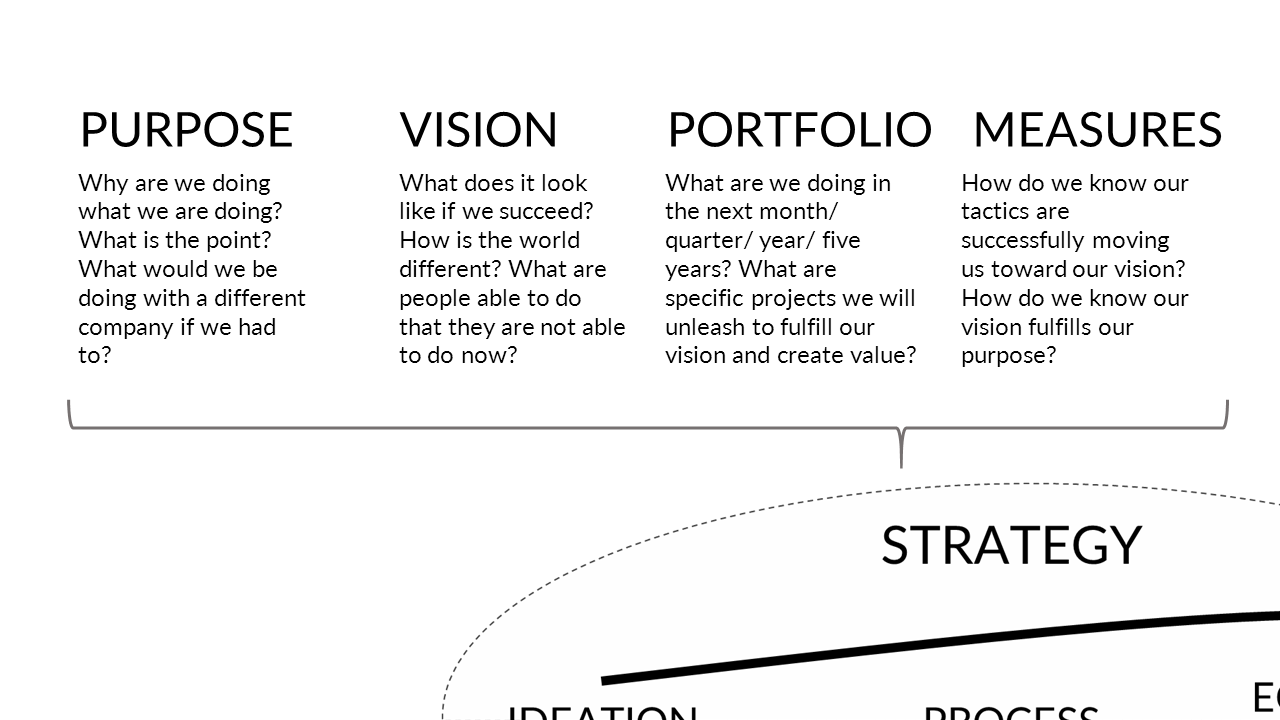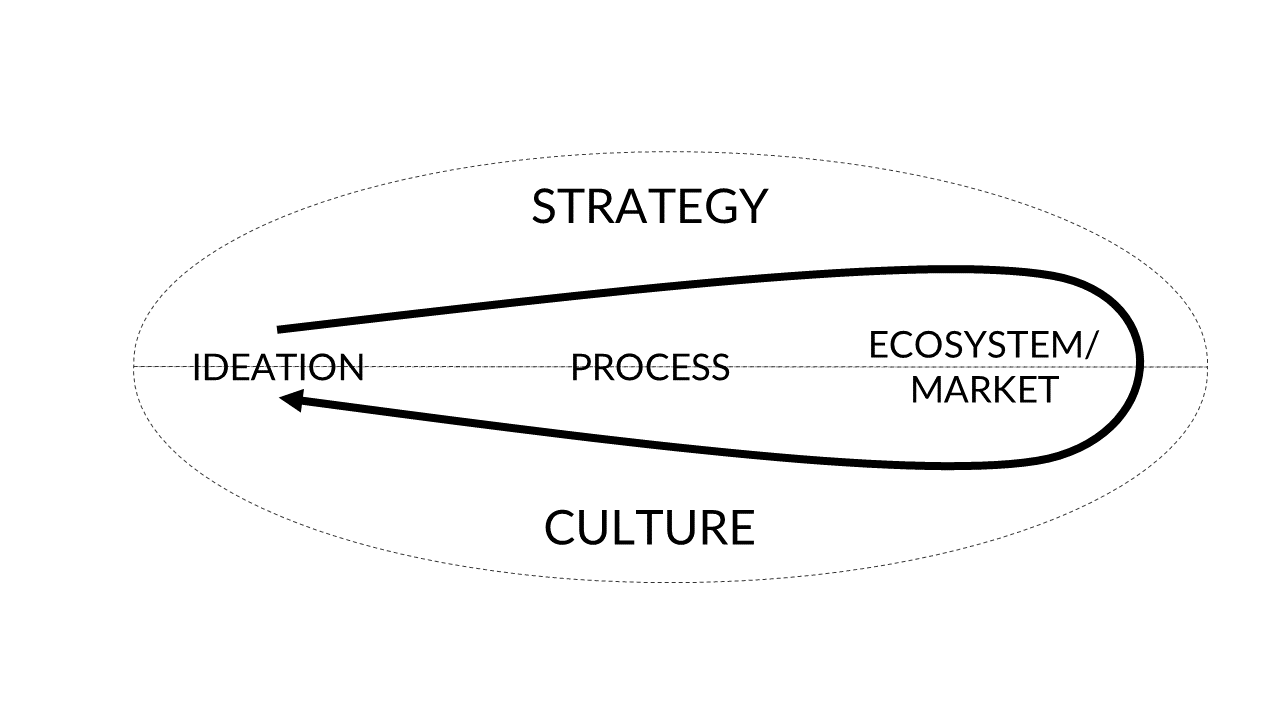To equip innovation leaders with tools for communicating about innovation requires a coherent and comprehensive framework that allows them to have conversations about innovation with the various stakeholders in the organization.
The following framework aims to provide a clear understanding of the content and the context for self-sustaining innovation. It outlines three levels of innovation:
- Project Innovation
- Continuous Innovation
- Self-Sustaining Innovation
They are not exclusive, rather build on top of each other. Project and Continuous Innovation are mostly concerned with content, while context is the key element for self-sustaining innovation. In order to create self-sustaining innovation in your organization it is essential to understand these levels and the components that make up each of them.
Most innovation initiatives have a clear beginning, middle, and, unfortunately, an end.
Project innovation
Most innovation initiatives fall into Project Innovation: they have a clear beginning, middle, and, unfortunately, an end: from initial ideation to deployment in the ecosystem. Whether the initiative succeeds or fails often determines the continuation of the overall innovation program. Oftentimes, this is the result of a limited definition of innovation as one of the subcomponents of innovation.
Innovation as ideation
When people who don’t work in innovation think of innovation, they often think of ideation. The Eureka moment, where an individual experiences sudden insight. But we know that individuals do not generate ideas in a vacuum, nor is ideation sufficient for innovation. Most ideation occurs in teams, and a process is required to turn this new idea into a profitable product.
Innovation as process
Fortunately, there are a growing number of tools and methodologies available to support the process of innovation. LEAN and Business Model Canvas are both examples of excellent companions in turning ideas into reality. Key here is to actually have a clear process for your innovation inside the company (ideally supported by innovation software and systems that encourage discipline and collaboration, and provide support in analysis). A comprehensive process aims to spark creativity and is focused on productivity from initial idea to rapid prototyping, and, as early as possible, involvement of your ecosystem partners.
Innovation as ecosystem play
An area of innovation that has become increasingly pertinent in a networked reality is that of the ecosystem. In a linear model, this is the recipient of your innovation and the people who support you in deploying it. The ecosystem consists of the totality of all stakeholders of the innovation, from traditional components like customers and vendors, to partners, competitors, adjacent industries, and the community at large.
Ideation, Process and Ecosystem: With these three components we have the foundation for Project Innovation, which, of course, is not the whole picture. It is shortsighted to stop here, but unfortunately, this is what many companies do. They treat Innovation as one-off product development. Many innovation efforts are solely focused on a next product or service. It is easy to run a course of innovation and feel like you tried and it’s okay to be done, write off the innovation investment, revert back to the core business and call it quits (keeping that head in the sand, waiting for the startup that will obsolete you).
When we are continuously applying insight, innovation becomes continuous…
Continuous innovation
In continuous innovation you keep revisiting the Project Innovation process. Everything remains in continuous beta as the team explores ever new ways of adding value to the ecosystem. Failure then becomes information. When we understand that everything is feedback, we begin to understand the value embedded in our failures. Failures provides us with enormous insights, which in turn can spawn off a new round of innovation. When we are continuously applying insight, innovation becomes continuous. Feedback serves as input for the next ideation process. Approaches like Agile development support this process.
However, there needs to be a context that provides a reason to revisit the innovation lifecycle and holds the foundation as you continue to visit the ideation process again and again. This is where many companies currently fall short. They treat innovation as a thing, rather than an emergent phenomenon, for which you create the conditions to occur.
Toward self-sustaining innovation
Context is shaped by purpose and culture. It provides answers to why are you innovating and how you are operating. Unfortunately, both purpose and culture are significantly lacking in most organizations.
Purpose as the foundation for innovation strategy
Purpose serves as the foundation of your innovation strategy. Purpose, together with your vision, your innovation portfolio and some measures as to how well the individual initiatives within your portfolio are achieving your vision and how well your vision is serving your purpose, make up your innovation strategy.
Purpose remains your North Star, while vision, your portfolio and metrics adjust as you gain feedback from your innovation lifecycle and as society evolves.
- Purpose is archetypal, e.g. “bring mobility to the world”, it is unconstrained.
- Vision is temporally constrained: the furthest you can see on the horizon, e.g. “a fleet of driverless cars by 2030”.
- Your vision inspires, breathes life into your Innovation Portfolio, the value creation initiatives you are committed to across the organization.
- Your Measures, both qualitative and quantitative, let you know if you are on track.
Without purpose leaders drift from one shiny thing to another and they lack the basis for courage to act, to step out of their comfort zone, and persevere in the face of obstacles. This lack of purpose also reflects in wavering top-level management support for innovation initiatives. In organizations that lack purpose, management focus shifts from commitment to quality products and services to the bottom line, from focus on long-term sustainable growth to short term financial results. Hence it is essential to anchor not just your innovation program, but your overall business in purpose – beyond how your current core business model fulfills it – think transportation not cars, accommodation not hotel rooms, healthcare not hospitals. Purpose is at the core of your innovation strategy, but unfortunately in recent research fewer than 20% of leaders in the US had a clear sense of purpose.
It is crucial that your purpose is future-oriented, uses meaningful language, and is focused on your strengths and aspirations – and that it’s personal. While we have given corporations personhood status, we seem to ignore that all organizations are made up of individuals. For them to be innovative, their personal purpose has to be clear and connected to the overall purpose of the organization.
Many companies lack a culture that sustains innovation
Culture can be defined as the underlying system of memes that shapes how you operate. Each individual has a cultural operating system. As we form groups and teams, and teams of teams – as in organizations – we co-create culture. While deeply influenced by the values and behaviors of the leadership, every member of the organization ultimately affects how you operate as an organization.
Without a strong cultural foundation, it will be challenging to sustain innovation.
Without a strong cultural foundation, it will be challenging to sustain innovation. Most cultures are averse to innovation. Systems and structures, policies and procedures have been put in place to secure the status quo. They are there to stabilize the core business – “how we do things around here.” This is antithetical to creating new solutions – especially solutions that would obsolete the current way of doing things. The thing is, though, if you don’t do it, someone else will, and before you know it, your core business has been made obsolete altogether.
Innovation culture
Creativity and Productivity are hallmarks of an innovation culture. This starts with every individual. For individuals to be creative, they need to experience themselves as safe in their environment. Safe to contribute, safe to fail. To create such an environment requires new ways of being and collaborating that respect each perspective, an understanding that ideas are born collectively, and the motivation for each individual to constantly drive toward an agreed upon purpose that is in line with their personal purpose.
Culture is the resulting interference pattern of the individuals in the organization, from the top leadership to the least senior employee. Everyone contributes, and everyone is key in mutually supporting desired cultural values and behaviors.
It is unreasonable to assume that an individual will become innovative from one day to the next. After having spent sometimes decades in command and control structures, it does require personal transformation and training to establish new ways of being and collaborating. New ways, where each individual understands themselves as the source of solution and the catalyst for evolutionary change.
In the end, it’s your people who are your most important asset.
Transforming toward self-sustaining innovation
Achieving this collective individual transformation is key to creating self-sustaining innovation in your organization. In the end, it’s your people who are your most important asset – begin treating them that way, give them the training and support they require, a clear purpose they connect to, and the freedom and encouragement to create and produce, and you will be amazed what solutions they source with you.
Conclusion
While each of these topics could be and has been written about extensively, this is meant to be an outline for a framework. Frameworks are less about answers than they are about asking good questions.
It is awareness and paying attention to each aspect of innovation that allows you to craft the field for coherent and self-sustaining innovation, one that gives equal value to the content to be created and the context you operate in; one that will outlast quarterly results, and one that will consistently create innovative new ways of achieving your purpose.
Supported by this model, innovation managers can have different conversations. This will allow them to clarify and strengthen the notion that innovation is not the innovation leaders job alone, but something every individual in the organization gets to embrace, and that it cannot be a separate effort, but has to be woven into the very fabric of the organization in order for it to self-sustain.
So ask yourself, where is your organization in this framework? Are you engaging in linear innovation – only concerned with creating a new product or service? Continuous innovation utilizing feedback as a means to continue to trigger the innovation lifecycle anew? Or do you have a clear a purpose and a culture, in which innovation is simply the way you do things?
By Philip H Horvath
About the author
 Philip serves as a culture catalyst and planetary strategist. Through his work with Luman and Future Ready Now he provides frameworks and operating metaphors to support leaders around the world in their individual evolution and in growing innovation capacity in their organizations. He has worked with startups, NGOs and with global Fortune 500 organizations in a variety of industries.
Philip serves as a culture catalyst and planetary strategist. Through his work with Luman and Future Ready Now he provides frameworks and operating metaphors to support leaders around the world in their individual evolution and in growing innovation capacity in their organizations. He has worked with startups, NGOs and with global Fortune 500 organizations in a variety of industries.
Photo: Business Woman Pushing Icon by Shutterstock.com











